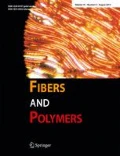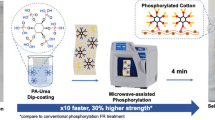Abstract
New methods for formulating flame retardant cotton fabrics have been achieved by applying a microwave-assisted technique with low amounts of solvent. Trials using cotton fabrics treated with casein from bovine milk and eco-friendly inorganic materials, urea and diammonium phosphate, were completed successfully. Thermogravimetric analysis (TGA), 45 ° angle (clothing textiles test), and limiting oxygen index (LOI) tests were carried out for the treated cotton fabrics. When the treated fabrics were tested using the 45 ° angle flame, the ignited fabrics self-extinguished and left behind a streak of char. Treated higher add-on fabrics were neither consumed by flame, nor produced glowing embers upon self-extinguishing. All untreated cotton fabrics showed limiting oxygen index (LOI) values of about 18 % oxygen in nitrogen. For formulations with casein, urea and diammonium phosphate, LOI values of treated fabrics were 32.0–44.0 % oxygen in nitrogen when add-on values for the formulation were 9.71–23.5 wt%. Furthermore, scanning electron microscope (SEM) was employed to characterize the chemical structure on the treated fabrics, as well as, the surface morphology of char areas of treated and untreated fabrics.
Similar content being viewed by others
References
S. Caddick, Tetrahedron, 51, 10403 (1995).
C. R. Strauss and R. W. Trainor, Aust. J. Chem., 48, 1665 (1995).
S. Q. Chen and Y. Wang, J. Mater. Chem., 20, 9735 (2010).
C. Gonzalez-Arellano, R. Luque, and D. J. Macquarrie, Chem. Commun., 30, 4581 (2009).
H. Dogan and N. D. Hilmioglu, Carbohydr. Polym., 75, 90 (2009).
A. Hou, X. Wang, and L. Wu, Carbohydr. Polym., 74, 934 (2008).
J. Li, L. Zhang, F. Peng, J. Bian, T. Yuan, F. Xu, and R. Sun, Molecules, 14, 3551 (2009).
S. Possidonio, L. C. Fidale, and O. A. E. Seoud, J. Polym. Sci. Part A Polym. Chem., 48, 134 (2009).
F. Carosio, A. D. Blasio, F. Cuttica, J. Alongo, and G. Malucelli, Ind. Eng. Chem. Res., 53, 3917 (2014).
G. Malucelli, F. Bosco, J. Alongi, F. Carosio, A. D. Blasio, C. Mollea, F. Cuttica, and A. Casale, RSC Adv., 4, 46024 (2014)
D. V. Parikh, T. A. Calamari, and D. B. Peterson, AATCC Rev., 2, 33 (2002).
W. A. Reeves, R. M. Perkins, and B. Piccolo, Text. Res. J., 40, 223 (1970).
E. D. Weil and S. V. Levchik, J. Fire Sci., 26, 243 (2008).
S. Gaan and G. Sun, Polym. Degrad. Stab., 92, 968 (2007).
ASTM D-2863-09, “Minimum Oxygen Concentration to Support Candle-like Combustion”, American Society for Standards and Testing, 2009.
ASTM D-1230-01, “Standard Test Method for Flame Resistance of Textiles”, American Society for Standards and Testing, 2001.
K. S. Muralidhara and S. Sreenivasan, J. Sci. Ind. Res., 69, 879 (2010).
S. Wang, Q. Liu, Z. Luo, L. Wen, and K. Cen, Front. Energy Power Eng. China, 1, 413 (2007).
T. M. Nguyen, S. Chang, B. Condon, R. Slopek, E. Graves, and M. Yoshioka-Tarver, Ind. Eng. Chem. Res., 52, 4715 (2013).
A. A. Faroq, D. Price, G. J. Milnes, and A. R. Horrocks, Polym. Degrad. Stab., 44, 323 (1994).
J. E. Hendrix, J. E. Bostic Jr., E. S. Olson, and R. H. Barker, J. Appl. Polym. Sci., 14, 1701 (1970).
E. Pacsu and R. F. Schwenker, Text. Res. J., 27, 173 (1957).
S. M. Liu, Y. Yang, Z. J. Jiang, Y. H. Zhou, J. Zuo, and J. Q. Zhao, J. Appl. Polym. Sci., 124, 4502 (2012).
K. Varga, M. F. Noisternig, U. J. Griesser, L. Alja, and T. Koch, Lenzinger Berichte, 89, 50 (2011).
Acknowledgment
The authors would like to acknowledge the U.S. Department of Agriculture for financial support of this work.
Author information
Authors and Affiliations
Corresponding author
Rights and permissions
About this article
Cite this article
Chang, S., Condon, B., Smith, J. et al. Flame Resistant Cotton Fabric Containing Casein and Inorganic Materials Using an Environmentally-Friendly Microwave Assisted Technique. Fibers Polym 21, 2246–2252 (2020). https://doi.org/10.1007/s12221-020-9965-x
Received:
Revised:
Accepted:
Published:
Issue Date:
DOI: https://doi.org/10.1007/s12221-020-9965-x




